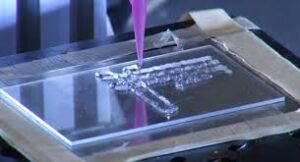The Dawn of 3D-Printed Hydrogels: Revolutionizing Biomedical and Soft Robotics Applications
Hello, fabric fanatics and material marvels! Today, we’re diving into an exhilarating advancement from the world of smart textiles and technical textiles. Picture this: researchers at North Carolina State University have concocted a 3D-printable hydrogel derived from the humble seaweed. Yes, you heard it right! This isn’t just your everyday gelatinous goo; it’s a high-tech marvel poised to make waves in biomedical fields and soft robotics. Join me, Textile Topher, as we unravel the intricacies of this groundbreaking research!
The Magnificent World of Hydrogels
Hydrogels, the squishy, water-laden substances many of us have encountered in everyday products like contact lenses and wound dressings, have taken on a new, high-tech avatar. Traditionally composed of polymers, hydrogels boast remarkable flexibility and water retention abilities. But despite these qualities, their mechanical properties—strength and durability—often leave room for improvement. This is where the innovative concoction from NC State steps in.
What Are Alginates?
Central to this cutting-edge work are alginates, naturally occurring biopolymers gleaned from seaweed and algae. These versatile chemical compounds have garnered fame as thickening agents in foods and as biocompatible materials in medical dressings. However, the team led by Professor Orlin Velev has unlocked new potentials by morphing alginates into a new form of hydrogel called “homocomposite hydrogels” (HHGs).

The Science Behind Homocomposite Hydrogels
In a breakthrough described in *Nature Communications*, researchers revealed that these HHGs are not merely water-based materials but high-performance structures. The key innovation here lies in merging two physical forms of alginates—micro- and nano-sized networks—into a single, reinforced entity. This interpenetrating network (IPN) forms what can be described as a “heterogeneous homogeny,” enhancing both strength and flexibility.
Homocomposite Hydrogels (HHGs)**: These unique hydrogels consist of interwoven networks at different scales. Specifically, a molecular alginate gel blends seamlessly with a colloidal network of hierarchically branched alginate soft dendritic colloids (SDCs). This structural synergy ensures that the resultant hydrogel is more robust and resilient.
Professor Velev emphasizes that integrating these alginate networks minimizes the fragility typically associated with hydrogels composed of disparate materials. “Water-based materials can be soft and brittle,” he explains. “But these homocomposite materials—soft fibrillar alginate particles nestled within a medium of alginate—function like two hydrogels in one.”
The Brawn Behind the Beauty
So, what makes these HHGs so remarkable? It’s all about the numbers:
Storage Modulus**: This parameter measures stored energy and elasticity. The HHGs exhibit a storage modulus that’s three times larger than either of its constituent networks.
Young’s Modulus**: A measure of stiffness, the HHGs show more than a fourfold improvement.
These quantifiable advancements translate into a material that’s not just theoretically superior but practically powerful. It’s like turning a standard bicycle into a high-performance motorcycle, all while keeping the same foundational components.
3D Printing: Shaping the Future
One of the most compelling aspects of this research is its application in 3D printing, offering on-demand manufacturing solutions that extend far beyond traditional possibilities. Imagine custom biomedical devices or soft robotic components being printed with precision and adaptability. The researchers aim to fine-tune this technique even further, potentially incorporating other types of gels for diverse applications.
3D Printing**: This transformative technology allows materials to be meticulously shaped layer by layer, utilizing digital models. When applied to HHGs, it promises the precise crafting of medical scaffolds, drug delivery patches, or even smart textile components.
Potential Applications: From Biomedicine to Soft Robotics
The versatility of these homocomposite hydrogels opens up a myriad of potential applications. Here’s a deeper dive into where they could make the most significant impact:
1. Biomedical Materials**: Alginates are already used in wound dressings due to their biocompatibility and hemostatic properties. Picture a new generation of 3D-printed bandages that conform perfectly to any wound, providing superior healing environments while possibly delivering timely medications.
2. Soft Robotics**: For the uninitiated, soft robotics deals with robots made from flexible materials, mimicking the dexterity of biological organisms. The newfound flexibility and strength of HHGs can serve as the foundation for more resilient and adaptable robotic systems. Imagine robots that can navigate through delicate environments like the human body without causing harm.
3. Food Industry**: Alginates are commonly used as thickening agents in food. With the new hydrogel properties, we could see the development of food with enhanced textures and perhaps new culinary experiences!
The Road Ahead
It’s clear that these findings are just the tip of the iceberg. The research team plans to advance their work by refining the merging process of these homocomposite materials, paving the way for even more robust and versatile applications. They also hint at experimenting with other types of gels commonly used in coatings or consumer products, further widening the horizon.
Conclusion: A Seaweed-Sourced Revolution
So there we have it, the next wave (pun intended) of intelligent, resilient materials emerging from something as unassuming as seaweed! This research underscores the importance of interdisciplinary innovation, blending chemistry, engineering, and materials science into a unified quest for better, smarter textiles. Stay tuned, dear readers, as developments like these hold the promise of transforming not just how we think about materials but fundamentally redefining what’s possible in textiles and tech.
Whether crafted into medical scaffolds or soft robotic limbs, these homocomposite hydrogels exemplify the future where biology meets high-tech engineering in the most sustainable and intelligent ways. And as always, I, Textile Topher, will be here to guide you through every stitch, every innovation, and every breakthrough! Keep the curiosity weaving and stay fabric-fantastic!
Keywords: Hydrogels**, Biomedical**, **Alginates**, (Post number: 100), **Soft Robotics**, **3D Printing**





